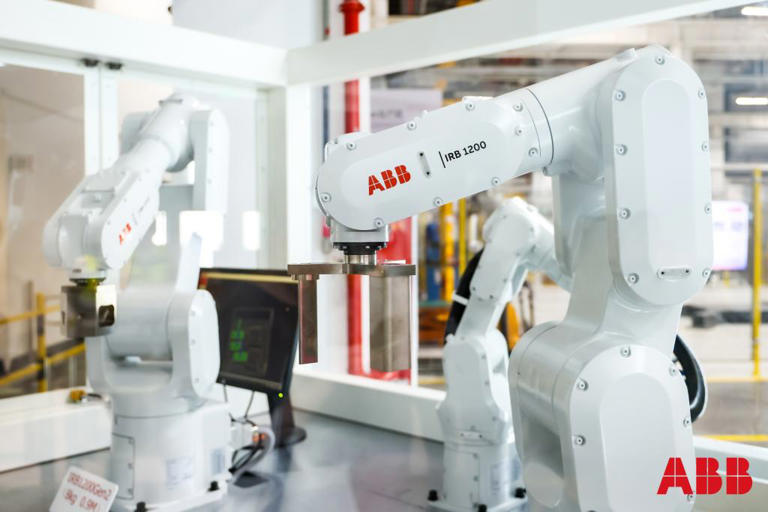Industrial robot giant ABB: Over 90% of the robots it provides for the Chinese market are locally produced
This article is reprinted from The Paper

In the Chinese industrial robot market, which is characterized by considerable growth, complex scenarios and highly flexible demands, there is no one-size-fits-all strategy. Foreign capital If enterprises want to maintain their market share, they must intensify their in-depth localization layout and catch up with the "China speed".
On July 2nd, ABB, a Swiss giant and one of the world's "Big Four" industrial robot manufacturers, launched three brand-new robot series, targeting the electronics and consumer goods industries
The automation demands in high-growth sectors such as general industry cover everything from basic applications like material handling to precision applications like gluing and polishing. New series of machines
Each person is produced by ABB's Shanghai Gigafactory, targeting the mid-range market in China, which has seen a compound annual growth rate of over 24% in recent years. ABB predicts that, to
This market segment is still expected to maintain a growth rate of approximately 8% in 2028.
More than half of the global robot installations are in China. "China is not only the world's largest market robots, is most important in the development of ABB global business market." AnShiMing ABB robot and discrete automation division President, said China's electronics manufacturing and other industries as well as the vigorous development of small and medium-sized enterprises, is generating strong demand for convenient and easy to use automation solutions. The company believes, flexible, modular, AI drive technology is reducing the dynamic threshold, the robot market release new vitality.
To know those news site, ABB is the new Lite + robot series, compact PoWa collaborative robot and a new generation of IRB 1200 small industrial robot series. Among them, PoWa directly targets the collaborative robot field where domestic manufacturers account for 90%. "We want to push before some high-end products to the market for customers in China should not only fast, and safe and multiple needs to carry on the design to the price is right." ABB robot, senior vice President, China Han Chen said that the series will be out a whole model in the next two years, ABB hope this business collaboration robot in China.
By 2028, the collaboration of robots in the industrial robot market accounted for more than 20%, the collaboration of robot market demand in China will reach about 100000 units. Collaborative robots are quite different in style and function from traditional industrial robots, just like two players of different magnitudes. Good at extremely high accuracy task collaboration robot, but considering the safety of collaboration with others, its running speed is relatively slow, general maximum linear speed is less than half of the traditional industrial robots, acceleration also is far lower than the traditional industrial robots.
By 2028, the collaboration of robots in the industrial robot market accounted for more than 20%, the collaboration of robot market demand in China will reach about 100000 units. Collaborative robots are quite different in style and function from traditional industrial robots, just like two players of different magnitudes. Good at extremely high accuracy task collaboration robot, but considering the safety of collaboration with others, its running speed is relatively slow, general maximum linear speed is less than half of the traditional industrial robots, acceleration also is far lower than the traditional industrial robots.
At the press conference, ABB also showcased an AI-driven natural language robot teaching software tool, which operates based on the PoWa collaborative robot. A raw combination of AI and analysis, through the "look and said," do "three simple steps, the robot through visual perception environment, real-time processing voice commands, and quickly transformed into precise movements. Han Chen said that as China's market share is getting higher and higher in the field of industrial robots, ABB robot market strategy is to "China first". "Chinese companies have some of the other countries did not appear, the more specific requirements. Before we use the international general products to adapt to the market, there are a lot of water.
Next, we will further increase investment in China and launch more "unique to China" products. "As we delivered the world's largest robot market in China, 90% of the products in the local production." Global head of ABB robot sales department Ma Sikang tell peng Pai news. It is understood that this year, the proportion of domestic suppliers for ABB robots will reach about 80%, basically achieving a closed loop within the Chinese supply chain. "After the machine more people no longer rely on programming to complete the task, but can use natural language to tell it what to execute, by its own programming." Ma Sikang believe that can provide autonomy and versatility of industrial robots will be the trend of the future. Robots can solve tasks independently without human intervention. Scenario in the factory, multi-functional robots can easily switch to the next item in the middle of the mission complete different tasks, such as from the screw to switch to the coating. Mobile can force, flexibility and understanding to the environment are the three independent functional robot technology backbone.